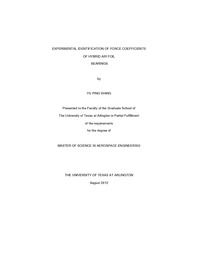
ATTENTION: The works hosted here are being migrated to a new repository that will consolidate resources, improve discoverability, and better show UTA's research impact on the global community. We will update authors as the migration progresses. Please see MavMatrix for more information.
Show simple item record
| dc.contributor.author | Wang, Yu Ping | en_US |
| dc.date.accessioned | 2013-03-20T19:10:52Z | |
| dc.date.available | 2013-03-20T19:10:52Z | |
| dc.date.issued | 2013-03-20 | |
| dc.date.submitted | January 2012 | en_US |
| dc.identifier.other | DISS-11838 | en_US |
| dc.identifier.uri | http://hdl.handle.net/10106/11518 | |
| dc.description.abstract | Successful applications for air foil bearings in small to midsize turbo-machinery have been acknowledged. Air foil bearings do not require oil lubricant thus they are capable of operating under much higher temperature than oil-lubricated bearings and they entail less maintenance costs if well-designed. However, when rotor size increases beyond 100 mm in diameter, reliability becomes an issue due to comparable increase in rotor weight with respect to increase in load capacity of the bearing. Furthermore, dry rubbing during starts and stops also causes concerns due to typical slow acceleration and deceleration characteristics of large turbo-machinery. The concept of hybrid air foil bearing was developed by Kim and Park to alleviate those concerns by introducing hydrostatic pressure inside the air film. Previous research on the hybrid air foil bearings indicates that hybrid air foil bearing can offer improvement in rotor stability and heat dissipation. In addition, significant reduction in dry friction at start/stop was also recorded from experimental investigations. Rotordynamics behavior depends on bearing stiffness and damping coefficients. They can be determined analytically form linear perturbation method using Reynolds equation. However, experimental identification for bearing force coefficients is critical in order to accurately classify and predict bearing performance under both normal and severe operating conditions. This thesis presents stiffness and damping coefficients of 4" diameter hybrid air foil bearing. A test rig formerly used for characterization of start-stop transient response was used for the experiment. The original 4" diameter hybrid air foil bearing was refurbished to improve its performance and assembly procedure. A frequency-domain technique is used to identify dynamic characteristics of the hybrid air foil bearing from measured impulse response using least square method. The measured bearing coefficients are in reasonable agreement with prediction from linear perturbation method. | en_US |
| dc.description.sponsorship | Daejong, Kim | en_US |
| dc.language.iso | en | en_US |
| dc.publisher | Aerospace Engineering | en_US |
| dc.title | Experimental Identification Of Force Coefficients Of Hybrid Air Foil Bearings | en_US |
| dc.type | M.S. | en_US |
| dc.contributor.committeeChair | Daejong, Kim | en_US |
| dc.degree.department | Aerospace Engineering | en_US |
| dc.degree.discipline | Aerospace Engineering | en_US |
| dc.degree.grantor | University of Texas at Arlington | en_US |
| dc.degree.level | masters | en_US |
| dc.degree.name | M.S. | en_US |
Files in this item
- Name:
- Wang_uta_2502M_11838.pdf
- Size:
- 3.583Mb
- Format:
- PDF
This item appears in the following Collection(s)
Show simple item record


